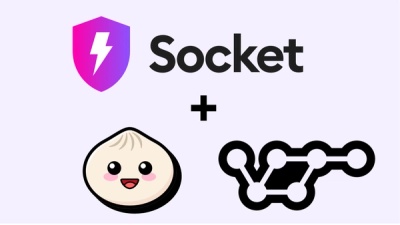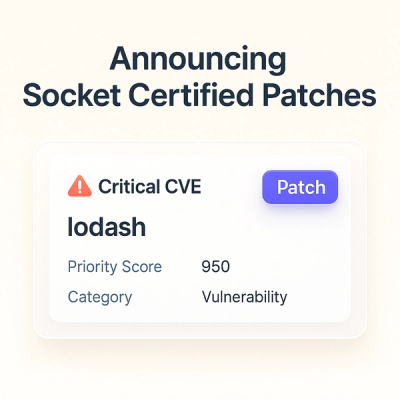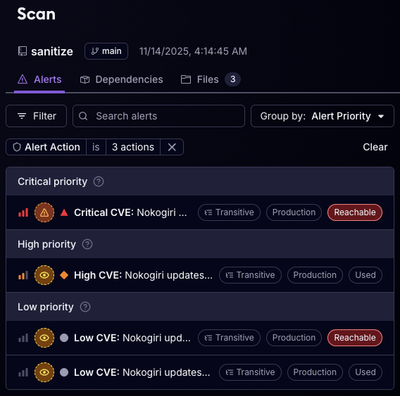
Product
Announcing Bun and vlt Support in Socket
Bringing supply chain security to the next generation of JavaScript package managers
@defi-wonderland/keep3r-cli-job-boilerplate
Advanced tools
@defi-wonderland/keep3r-cli-job-boilerplate aims to provide protocols an easy way of creating a CLI compatible job, just start by forking this repo.
As well, this repository includes testnet jobs that can be installed and tested without any real costs.
This repository comes with some jobs deployed to goerli that serve as a safe and easy way to test whether users running Keep3r CLI have setup their keepers correctly. These jobs are:
package.jsonREADME.mdLICENSECreate a github repository and add a secret named NPM_TOKEN
This token can be generated in npmjs.com -> account -> access tokens -> generate new token -> add name and select the publish type
Update eth-sdk/config.ts with your relevant contracts and chain
Adapt src to fit your job while maintaining the same structure
As soon as you merge into a branch called main, a deployment to npm will occur
metadata.json: Super simple .json file containing the name of the job. This is an example of how it would look like if your job was called My First Job.
{
"name": "My First Job"
}
Right now this file seems unimportant, but in future versions it will be used to add extra information about each specific job. An example of this, would be the tokens the job uses to pay the keepers—right now we assume they pay in KP3R or ETH—which will help the Keep3r-CLI properly calculate the profitability of the transaction. In the current version, the name is used to create an id for each job, which will help the Keep3r-CLI know which job is currently in progress to avoid rerunning it unnecessarily.
job.ts: This file will contain the logic of the job script, and therefore it will be the file the Keep3r-CLI runs when it intends to work your job. Writing the logic in this file can sound like a daunting task at first, but we have built everything so that there's a lot of shared logic between scripts, which makes creating a script for your job a simple task.
After going through the examples you will find that all the jobs follow a similar pattern to this one:
Declare a variable that contains the address of your job.
Create an async function called getWorkableTxs which will take args as arguments. This function will contain all the important logic to create what we call workable groups and send them along with an id to the Keep3r-CLI.
A workable group is an array that contains objects that have:
For example, let's say ExampleJob needs a keeper to call the work function and let's say the keeper establishes 100 as the target block. When a keeper executes getWorkableTxs, this function will output the following working group:
workableGroup = [{
targetBlock: 100,
txs: [populated tx data to call work],
logId: some randomly generated id
}]
This working group will then be passed to the Keep3r-CLI job-wrapper.ts file, for additional checks before sending the transactions to flashbots.
All of the following points will be different points of logic inside getWorkableTxs
Create a correlationId, which will be used to track if the current job being executed to avoid rerunning it unnecessarily.
Create an if check that checks, using the correlationId, whether that job should be rerun in a block or not. For example: the keeper runs your job at block 100, but specifies 105 as its target block. The correlationId and this additional check will prevent all the logic to check whether the job is workable or not from being rerun in the blocks 101, 102, 103, 104, where it's not necessary.
Create a variable logMetadata containing all the relevant information you would like the keeper to see in their logs. We recommend creating an object containing the name of your job, the current block, and a logId to help identify each job.
Create a logConsole variable that calls the prelog utility function passing in the logMetadata as an argument. This is simply used to log better logs. It appends all the information established in logMetadata to each log that uses logConsole instead of console.log
Create a variable containing your job's contract. This will be used to populate the transactions the keeper will end up running.
Create a try catch finally statement.
The try statement will call the work function to check if, in the current block, that job can be worked or if it's on cooldown. If it is workable, it adds a log and then creates a workableGroup variable initialized to an empty array.
Things get interesting after this. Because we know the job is workable, we can now populate the transactions we will need to send to flashbots in order to execute this job, and then push an object containing those transactions along with the target block and id of each one to our workableGroup.
To populate transactions for consequent blocks we use a for loop that will push as many objects to workableGroups as the keeper has passed as the bundleBurst parameter. In these objects, the array of populated transactions will always be the same, but the target block and the id will change.
If everything went well, getWorkableTxs sends an object containing the workable groups and the current job correlationId to the Keep3r-CLI, which will be received by job-wrapper.ts.
The catch statement will catch any error and log out a message for the keeper to read. The most common error that will occur is that the job is currently in cooldown, therefore it can't be worked.
The finally statement will kill the process once it has concluded.
Lastly, and outside the getWorkableTxs function, we export getWorkableTxs.
This is the shared structure among jobs and it's exactly the structure that can be found in the JobA example we provide. However, some jobs will have protocol-specific logic that will modify this structure ever-so-slightly.
For example: some jobs will have multiple strategies that need to be run. Others will require the keeper to call a function before calling the work function. For these two cases we have provided examples that show how to modify the basic structure to add protocol-specific features:
harvest-v2, tend-v2, tend-v2-2.dcaharvest-v2, jobAStealthIf you still have doubts as to how to implement a script for your job, reach out to us!
FAQs
Keep3r CLI Job Boilerplate
We found that @defi-wonderland/keep3r-cli-job-boilerplate demonstrated a not healthy version release cadence and project activity because the last version was released a year ago. It has 5 open source maintainers collaborating on the project.
Did you know?

Socket for GitHub automatically highlights issues in each pull request and monitors the health of all your open source dependencies. Discover the contents of your packages and block harmful activity before you install or update your dependencies.

Product
Bringing supply chain security to the next generation of JavaScript package managers

Product
A safer, faster way to eliminate vulnerabilities without updating dependencies

Product
Reachability analysis for Ruby is now in beta, helping teams identify which vulnerabilities are truly exploitable in their applications.